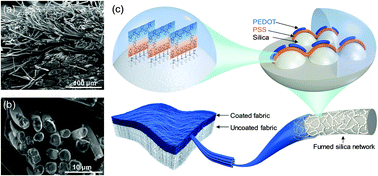All-organic flexible fabric antenna for wearable electronics†
Abstract
Next-generation wearable systems call for flexible, breathable, and skin-friendly wireless transmitters for realizing body area networks and the internet of things. This work presents the first fully functional, poly(3,4-ethylenedioxythiophene):polystyrene sulfonate (PEDOT:PSS) screen-printed fabric patch antenna for next-generation wearable antennas. This is an unparalleled milestone as prior conductive polymer based fabrics all demonstrated insufficient RF radiation due to skin effect loss, whereas here, an all-organic fabric RF transmitter is realized with the help of nanotemplate-assisted PEDOT:PSS conductive phase segregation on the surface of fabric fibers, forming a continuum coaxial structure with a conductive shell. This multi-strand wire structure endows the conductive fibers with a high surface area that is similar to high frequency Litz-wire, resulting in an extremely high RF conductivity. The fabricated patch antenna based on this conductive fabric shows an extremely low return loss of −50 dB and a satisfactory radiation efficiency of 28% at its resonant frequency of 2.35 GHz, and preserves its performance characteristics when bent over a representative phantom. In addition, the Doppler radar system based on the fabric patch antennas demonstrates satisfactory speed and distance detection with high precision, well suited for future application as a short-range sensing device for blind assistance. This development paves a new way to fabricate all-organic flexible RF devices for wireless communication with profound implications for the field of integrated wearable electronic networks.



 Please wait while we load your content...
Please wait while we load your content...